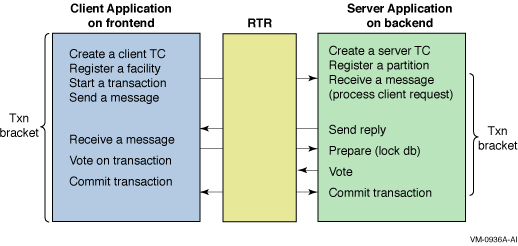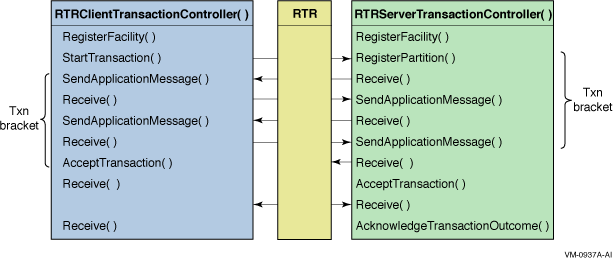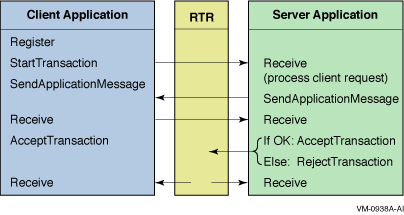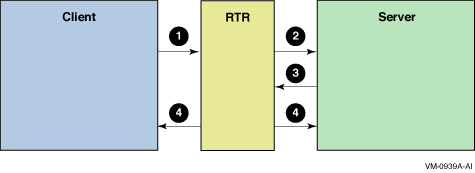| Previous | Contents | Index |
One method for improving response time is to send multiple messages from clients without waiting for a reply. The messages can be sent to different partitions to provide parallel processing of transactions.
For certain read-only applications, RTR can be used without shadowing to establish sites to protect against site failure. The method is to define multiple non-overlapping facilities with the same facility name across a network that is geographically dispersed. In the facility, define a failover list of routers, for example, some in one city, some in another. Then when the local router fails, a client is automatically reconnected to another node. If all local nodes in the facility are unavailable, the client is automatically connected to a node at the alternate site.
Another method is to define a partition on a standby server for read-only transactions. This minimizes network traffic to the standby. A read-only partition on a standby server can reduce node-to-node transaction locking.
Generally, databases (and applications built to work with them) are required to be idempotent. That is, given a specific state of the database, the same transaction applied many times would always produce the same result. Because RTR relies on replays and rollbacks, if there is a server failure before a transaction is committed, RTR assumes the database will automatically roll back to the previous state, and the replayed transaction will produce results identical to the previous presentation of the transaction. RTR assumes that the database manager and server application provide idempotency.
For example, consider an internet transaction where you log into your bank account and transfer money from one account to another, perhaps from savings to checking. If you interrupt the transfer, and replay it two hours later, the transfer may not succeed because it would be required to have been done within a certain time interval after the login. Such a transaction is not idempotent.
In a heterogeneous environment, you can use RTR with several hardware architectures, both little endian and big endian. RTR does data marshalling in your application so that you can take advantage of such a mixed environment.
If you are constructing an application for a heterogeneous environment:
With RTR, applications can run on systems from more than one vendor. You can mix operating systems with RTR, and all supported operating systems and hardware architectures can interoperate in the RTR environment. For example, you can have some nodes in your RTR configuration running OpenVMS and others running Windows NT.
To develop your applications in a multivendor environment:
An existing application written using RTR Version 2 with OpenVMS will still operate with RTR Versions 3 and 4. Refer to the Reliable Transaction Router Migration Guide for pointers on using RTR Version 2 applications with RTR Version 3, and moving RTR Version 2 applications to RTR Version 3 or 4.
This chapter provides information on RTR transaction model and recovery concepts for client and server applications implemented with the C++ API. Topics include :
Additional information on RTR transactions and recovery can be found in the Application Implementation chapter of this guide and in Reliable Transaction Router Getting Started.
Figure 4-1 illustrates frontend/backend interaction with pseudo-code for transactions and shows transaction brackets. The transaction brackets show the steps in completing all parts of a transaction, working from left to right and top to bottom. In the figure, TC stands for transaction controller.
Figure 4-1 Transactional Messaging with the C++ API

The transaction is initiated at "Start transaction" on the frontend, and completed after the "Commit transaction" step on the backend. The transaction ID is encoded to ensure its uniqueness throughout the entire distributed system. In the prepare phase on the server, the application should lock the relevant database (DB) records. The commit of a transaction hardens the commit to the database. Figure 4-2 illustrates a typical call sequence between a client and server application. These calls are RTRClientTransactionController and RTRServerTransactionController class methods. The first call in both the client and server transaction controllers is to create a new transaction controller, for example, in the server, use RTRServerTransactionController::RTRServerTransactionController.
Figure 4-2 C++ API Calls for Transactional Messaging

For a client, an application typically uses the following methods in this order:
Client first creates a transaction controller and a facility.
The client sends a request to the server.
After the server has processed the request, the client calls Receive and the data object contains the RTR message rtr_mt_reply , causing the client message handler OnInitialize and OnApplicationMessage methods to be called.
The client calls AcceptTransaction, if all went well.
For a server, an application typically uses the following methods in this order:
On the first server transaction controller Receive, RTRData contains rtr_mt_msg1 . With event-driven processing (the default behavior) the server message handler calls OnInitialize and then calls OnApplicationMessage.
On a second Receive from a client SendApplicationMessage, the RTR message received in the data object contains rtr_mt_msgn , causing OnApplicationMessage to be called by the server message handler.
After processing the client's request, the server calls SendApplicationMessage.
When the client accepts the transaction, the server Receive call includes rtr_mt_prepare from RTR.
The server accepts the transaction.
RTR sends rtr_mt_accepted
With event-driven processing, the appropriate methods in the
RTRClientMessageHandler and RTRServerMessageHandler classes
are called by RTRData::Dispatch. You must use the
RTRClientTransactionController::RegisterHandlers and
RTRServerTransactionController::RegisterHandlers methods to enable this
default handling.
Data-content routing is the capability provided by RTR to support the partitioned data model. With the C++ API, you define partitions with the RTRPartitionManager class. Partitions are defined with partition name, facility name and KeySegment attributes. Using RTR data-content routing, message content determines message destination. The routing key, defined in the C++ API RTRKeySegment class is embedded within the application message. When a server is started, the server informs RTR that it serves a particular partition.
When a client sends a message that references that particular partition, RTR knows where to find a server for that partition and routes the message accordingly. Even if the server is moved to another location, RTR can still find it. The client and the application do not need to worry about locating the server. This is location independence.
The benefits of data-content routing are simpler application development and flexible, scalable growth without application changes. RTR hides the underlying network complexity from the application programmer, thus simplifying development and operation.
With Set State methods within the RTRServerTransactionProperties class, users can change a transaction state in their application servers. With the event-driven processing model, your states are shown through the message handlers. In the polling model, the states are accessed with an RTRData::GetMessageType() call.
Consider the following scenario: upon receiving an rtr_mt_accepted message indicating that a transaction branch is committed, the server normally performs an SQL commit to write all changes to the underlying database. However, the server that is to detect the SQL commit or the underlying database may be temporarily unavailable.
With the C++ API, you can change the state of a transaction to EXCEPTION using the SetStateToException method, to temporarily put this transaction in the exception queue. When things get better, users can call SetStateToCommit or SetStateToDone to change the transaction state back to COMMIT or DONE, respectively.
The following example shows how a transaction state can be changed using the set state methods. See the RTRServerTransactionProperties class documentation in the Reliable Transaction Router C++ Foundation Classes manual for more details.
(RTRServerTransactionProperties::SetStateToException();) RTRServerTransactionProperties_object_name.SetStateToException(stCurrentTxnState);) |
The parameter
stCurrentTxnState
is a transaction state of type
rtr_tx_jnl_state_t
.
Normally at the RTR command level, users need to provide at least facility name and partition name qualifiers to help RTR select a desired set of transactions to be processed. Because a transaction's TID (rtr_tid_t) is unambiguously unique, a user needs only to specify the transaction's current state and its TID.
Note that if a transaction has multiple branches running on different partitions simultaneously on this node, RTR will reject this set transaction request with an error. RTR can only change state for one branch of a multiple partition transaction at a time.
RTR calls (and responses to them) contain RTR message types (mt) such as rtr_mt_reply or rtr_mt_rejected . There are four groups of message types:
Table 4-1 lists all RTR message types.
| Transactional | Status | Event-related | Informational |
|---|---|---|---|
| rtr_mt_msg1 | rtr_mt_accepted | rtr_mt_user_event | rtr_mt_opened |
| rtr_mt_msg1_uncertain | rtr_mt_rejected | rtr_mt_rtr_event | rtr_mt_closed |
| rtr_mt_msgn | rtr_mt_prepare | rtr_mt_request_info | |
| rtr_mt_reply | rtr_mt_prepared | rtr_mt_rettosend |
Applications should include code for all RTR expected return message types. Message types are returned to the application in the message status block. For more detail on message types, see the Reliable Transaction Router C Application Programmer's Reference Manual .
Figure 4-3 illustrates transactional messaging interaction between a client application and a server application using C++ API calls.
Figure 4-3 Flow of a Transaction

In Figure 4-3:
RTR sends both the server and the client a message that either declares that the transaction was accepted or rejected.
All the above steps comprise two parts of a transaction:
Message processing involves a message being sent by a client and a reply coming back from one or more servers. This is where the business application processing takes place.
The typical steps during message processing are:
Figure 4-4 illustrates the accept-processing portion of a completed RTR transaction.
Figure 4-4 Accept Processing

The steps in accept processing are:
There is one way to start a transaction - explicitly by creating a server transaction controller object, registering a facility, and using StartTransaction. The SendMessage call sends a message as part of a transaction from a client. If there is no transaction currently active on the transaction controller, a new one is started. The AcceptTransaction can be bundled with the last message. The SendMessage call also sends a reply message from a server to the client. The reply message is part of the transaction initiated by the client. A transaction is defined as a group of messages initiated by the client. The server knows that a transaction has begun when it receives a message of one of the following types:
If transaction timeouts are not required, the transaction starts on the next SendMessage call.
The Register call enables the transaction to join another transaction or set a transaction timeout. When a transaction is started implicitly, the timeout feature is disabled. A client has two options for message delivery after a failure:
When a message is received, the message status block contains the transaction identifier (TID).
You can use the GetTID call to obtain the RTR transaction identifier for the current transaction. This identifier is a unique number generated by RTR for each transaction. The application can use the TID if the client needs to know the TID to take some action before receiving a response.
The AcceptTransaction call by the client begins the prepare phase of the two- phase commit protocol. An accepted transaction is not complete until a message of type rtr_mt_accepted or rtr_mt_rejected is received.
The application can specify a reason on the AcceptTransaction method so that the caller can specify an accept reason that is passed on to all participants in the transaction. If more than one transaction participant specifies a reason, the reason values are ORed together by RTR. The accept is final: the caller cannot reject the transaction later. The caller cannot send any more messages for this transaction.
A client can accept a transaction in one of two ways: with the AcceptTransaction call or by using the SetAcceptTransaction method. Using the SetAcceptTransaction method removes the need to issue an AcceptTransaction method and can help optimization of client traffic. Merging the data and accept messages in one call puts them in a single network packet. This can make better use of network resources and improve throughput.
Any participant in the transaction can call RejectTransaction. The reject is final and it is impossible for the caller to accept the transaction later. The RejectTransaction method rejects a transaction. Once the transaction has been rejected, the caller receives no more messages for this transaction.
The server can call the ForceRetry method to have RTR redeliver the transaction beginning with rtr_mt_msg1 without aborting the transaction for other participants. Using the RejectTransaction method, the application can specify a reason that the caller can pass on to all participants in the transaction. If more than one transaction participant specifies a reason, the reason values are ORed together by RTR.
A server application can end a transaction by either accepting or rejecting the transaction. RTR can reject a transaction at any time after the transaction is started but before it is committed. For example, if RTR cannot deliver a transaction to its destination, it rejects the transaction and delivers the reject completion status to all participants that know about the transaction.
A transaction is accepted explicitly with the AcceptTransaction method, and rejected explicitly with the RejectTransaction method. RTR can reject a transaction at any time once the transaction is started but before it is committed. If RTR cannot deliver a transaction to its destination, it rejects the transaction explicitly and delivers the reject completion status to all participants.
A transaction participant can specify a reason for an accept or reject on the AcceptTransaction and RejectTransaction methods. If more than one transaction participant specifies a reason, RTR uses the OR operator to combine the reason values together. For example, with two servers, A and B, each providing a reason code of 1 or 2, respectively, the client receives the result of the OR operation, reason code 3, in its message buffer in RTRData.
A transaction is done once a client or server application receives a completion message, either an rtr_mt_accepted or rtr_mt_rejected message from RTR. An application no longer receives messages related to a transaction after receiving a completion message or if the application uses RejectTransaction A client or server can also specify SetForgetTransaction to signal its acceptance and end its involvement in a transaction early. RTR returns no more messages (including completion messages) associated with the transaction; any such messages received will be returned to the caller.
A client or server application no longer receives messages related to a transaction after it receives an OnAccepted or OnRejected message from RTR, or if the application called RejectTransaction.
This section summarizes the default behavior of the client and server transaction controller objects when they interact in processing a transaction. When a transaction controller receives an RTRData object, it receives an RTR message. With the event-driven model of processing, Dispatch is automatically called and the appropriate methods, based on the RTR message, execute by default. For tables of the RTR to C++ API mapping of messages and events, see the Reliable Transaction Router C++ Foundation Classes manual. Table 4-2 lists commonly used server transaction controller methods.
| ServerTransactionController | RTR Message within RTRData | Event- Driven Default Calls | Default Behavior |
|---|---|---|---|
|
RTRServerTransactionController::
RegisterPartition() |
NA (not applicable) | NA | Creates a partition. |
|
RTRServerTransactionController::
RegisterHandlers() |
NA | NA | Registers server message and event handlers with the server transaction controller. |
|
RTRServerTransactionController::
Receive() |
rtr_mt_msg1 |
OnInitialize
OnApplicationMessage |
Receives application message. |
|
RTRServerTransactionController::
Receive() |
rtr_mt_msgn | OnApplicationMessage | Receives application message. |
|
RTRServerTransactionController::
SendApplicationMessage() |
NA | NA | Sends application message. |
|
RTRServerTransactionController::
Receive() |
rtr_mt_prepare | OnPrepare | Receives application message. |
|
RTRServerTransactionController::
AcceptTransaction |
NA | NA | Accepts transaction. |
|
RTRServerTransactionController::
Receive() |
rtr_mt_accepted | OnAccepted | Receives application message. |
|
RTRServerTransactionController::
Receive() |
rtr_mt_rejected | OnRejected | Receives application message. |
To register two partitions, create two partitions and call Register once for each. Table 4-3 lists basic client transaction controller methods.
| ClientTransactionController | RTR Message within RTRData | Event- Driven Default Calls |
|---|---|---|
| RTRClientTransactionController:: Receive() | rtr_mt_reply |
RTRServerMessageHandler:: (OnInitialize)
RTRServerMessageHandler:: (OnApplicationMessage) |
| RTRClientTransactionController:: AcceptTransaction() | rtr_mt_accept | |
| RTRClientTransactionController:: Receive() | rtr_mt_accepted | OnAccepted |
For more information on RTRTransactionController methods, refer to the Reliable Transaction Router C++ Foundation Classes manual.
| Previous | Next | Contents | Index |